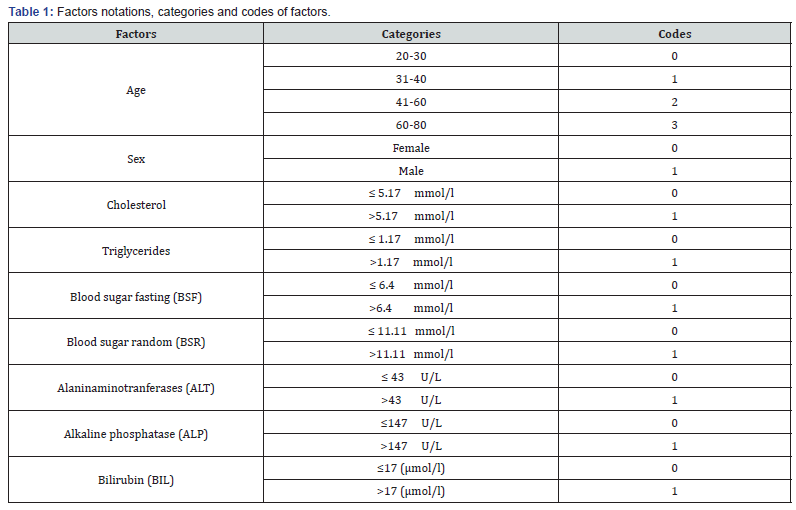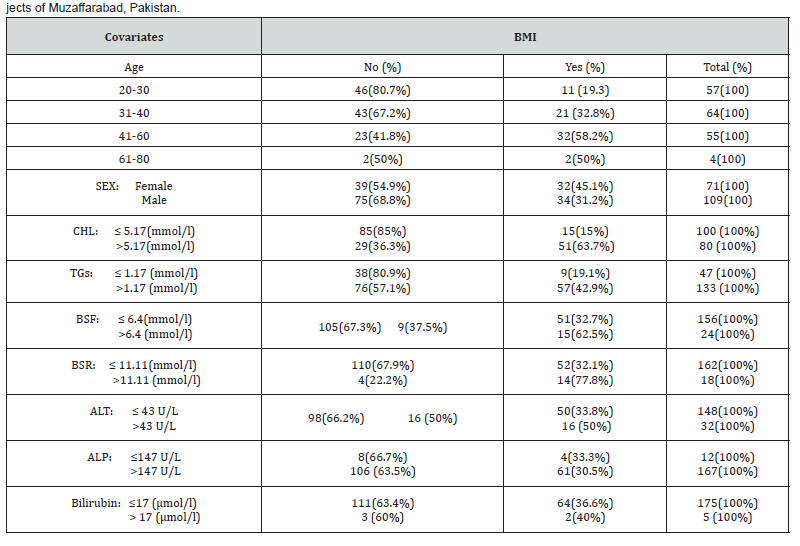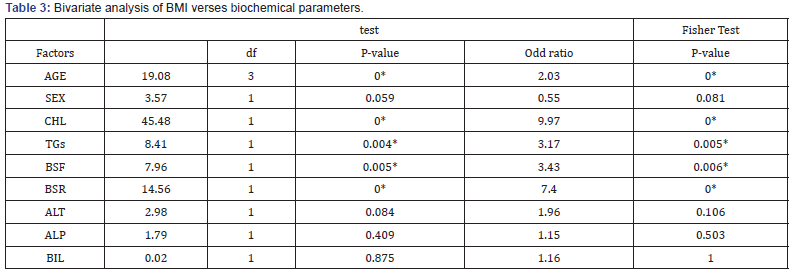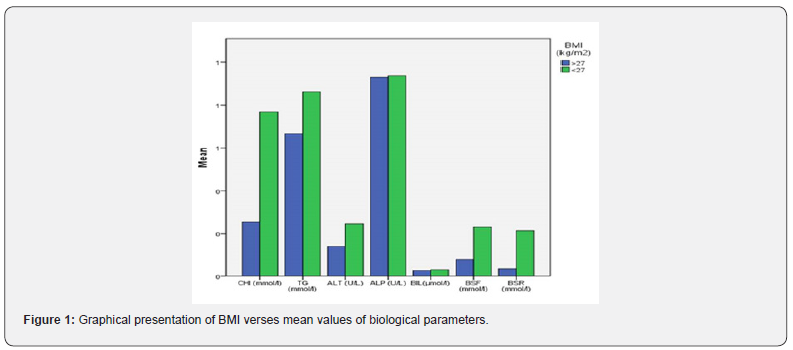An Association of Blood Sugar, Cholesterol and Triglycerides with Obesity in Human Subjects from Muzaffarabad Azad Kashmir, Pakistan
Raja Amjad Waheed Khan1*, Liaquat Hussain Khan1, Abdul Rehman Khan1, Kamran Abbas2, Khawaja Ansar Yasin1, Zahid Azeem3, Imran Aftab4 and Zahid Majeed5
1 Department of Chemistry, University of Azad Jammu and Kashmir, Pakistan
2 Department of Statistics, University of Azad Jammu and Kashmir, Pakistan
3 Azad Jammu and Kashmir Medical College Muzaffarabad, Pakistan
4City Diagnostic Laboratory Muzaffarabad, Pakistan
5Department of Biotechnology, University of Azad Jammu and Kashmir, Pakistan
Submission: May 11, 2020; Published: June 09, 2020
*Corresponding author: Raja Amjad Waheed Khan, Department of Chemistry University of Azad Jammu and Kashmir Muzaffarabad, 13100 Pakistan
How to cite this article: Raja A W K, Liaquat H K, Abdul R K, Kamran A, Khawaja A Y, et al. An Association of Blood Sugar, Cholesterol and Triglycerides with Obesity in Human Subjects from Muzaffarabad Azad Kashmir, Pakistan. 2020; 13(3): 555861. DOI: 10.19080/CRDOJ.2020.13.555861
Abstract
Background: Obesity is a complex disorder which is characterized by excessive accumulation of fats in different organs of body. The present study was carried out to find an association of body mass index (BMI) with blood glucose, Cholesterol, Triglycerides, as well as liver function tests, in obese and non-obese human subjects from Muzaffarabad, Azad Kashmir Pakistan.
Materials and Methods: Total 180 adult healthy human subjects of both genders were included in this study. The cut off BMI value of >27 kg/m2 was used for obese and ≤ 27 kg/m2 for their non-obese counterpart. Fasting and random blood was obtained from the subjects and afore mentioned parameters were determined by using Micro Lab 300.
Results: In our analysis, we have found significant association of cholesterol (=45.48, OR=9.97 P=0), triglycerides (=8.41, OR=3.17, P=0.004,) fasting blood glucose (= 7.96, OR=3.43 P=0.005,) and random blood glucose (=14.56, OR =7.4, P =0) with BMI. Moreover, these parameters were also found to be associated with age (=19.08, OR =2.03, P=0). Additionally, logistic regression along with Akaike information criterion (AIC) and Bayesian information criteria (BIC) were also adopted with calculated value of AIC=184.1217 and BIC= 200.0865 which indicated that model seems to be a good model.
Conclusion: From this study we may conclude that cholesterol, triglycerides and blood sugar level are strongly associated with obesity. Therefore, obesity might be considered a risk for the development of hypertension, cardiovascular disorder and diabetes. This study may be a tangible support to address the obesity by using the above-mentioned parameters.
Keywords:Cholesterol; Triglycerides; Blood sugar level; Obesity; Hypertension; Cardiovascular disorder; Diabetes; Ischaemic heart disease; High caloric diet; Overweight; Cholesterol; Triglycerides
Abbreviations: BMI: Body Mass Index; AIC: Akaike Information Criterion; BIC: Bayesian Information Criteria; OSA: Obstructive Sleep Apnea; NCDs: Non-Communicable Diseases; ALT: Alanine Amino Transferase; GGT: Gamma Glutamyl Transferase; AST: Amino Aspartate Transferase; WMA: World Medical Association; VLDL: Very Low Density Lipoprotein; BSR: Blood Sugar Random; BSF: Blood Sugar Fasting; WHR: Waist-to-Hip Ration
Introduction
Obesity is an excessive buildup of fats in the human body which leads to many ailments. Recently, WHO has documented that 1.9 billion adults of age 18 year and above were found to be overweight and 650 million of them were considered obese. The 41 million kids of the age below 5 years were also found overweight or obese. The prevalence of adiposity in children has increased enormously from 4% in 1975 to 18% in 2016 [1]. Obesity has been found to be involved in many health impairments like cardiovascular disorders, high blood pressure, type-2-diabetes mellitus, obstructive sleep apnea (OSA), hyperlipidemia, osteoarthritis, fatty liver disease and certain cancers. The contribution of obesity to the global burden of disease was estimated as 12%, 8% and 32% respectively for colon, breast and endometrial cancer in females. Similarly, the contribution of obesity in the development of diabetes has been calculated as 64% and 77% for male and females respectively. The share of adiposity in the development of Ischaemic heart disease is 33 % and for hypertension and osteoarthritis, it is also 50% and 25% respectively [2]. The contribution of obesity to the adult human casualties has been calculated approximately 3.4 million yearly [3]. The obesity is strongly associated with diabetes and cardiovascular disease. Both the waist circumference and BMI are indicators of diabetes, hypertension and risk for cardiovascular disorder [4].
Currently obesity is also pandemic in Pakistan. It is more prevalent in urban population than rural population. It has also been observed that the prevalence of obesity is more pronounced in females of all age groups than men in Pakistan [5]. The various studies conducted in south Asian region indicated that excessive TV watching, prolonged use of computer, junk and high caloric diet and low physical activity are the main contributor to obesity and overweight [6].
In Pakistan like other south Asian countries, social and natural changes are happening quickly, with expanding urbanization, evolving ways of life, energy-rich diet, and sedentary lifestyle. The concurrence of underweight in childhood and adiposity in grownups may be a predictor for a high predominance and frequency of non-communicable diseases (NCDs) like high blood pressure and diabetes. The determination of obesity by using cut off values of BMI for Asian (BMI >23 for overweight, and BMI ≥27for obese) in Pakistan may predict the health more precisely [7]. Laboratory liver function tests are characterized as valuable indicators for the diagnosis and cure of liver diseases. The liver is the site for metabolism of proteins, carbohydrates, and lipids. Enzymes and some end products of metabolic reactions are extremely sensitive to the anomaly happening and may be thought of as a biochemical marker of liver pathology. These may include serum bilirubin, gamma glutamyl transferase (GGT), alanine amino transferase (ALT), and amino aspartate transferase (AST), the (AST/ALT) ratio. However, a single liver test is not a satisfactory indicator of liver disease as some serious disorder may have a normal level of liver test and in contrary abnormal levels might be found in healthy persons [8].
Elevated serum level of liver enzymes is an indicator of liver injury. The higher serum level of liver enzymes have been found associated with glucose intolerance, type-2-diabetes and metabolic syndrome. Abdominal fat accumulation is more related to higher level of serum liver enzyme as compared to the high value of BMI [9]. Obesity is the major contributor to type-2-diabetes, the excessive and inappropriate regional distribution of fat induces the inflammatory response which causes glucose intolerance and also hampers insulin production [10]. A study conducted earlier in pairs of twin revealed a higher level of fasting insulin and low sensitivity in both genders. This was more prominent in the subjects with higher percentage of fat in abdominal area. The onset of insulin resistance induces many metabolic disorders which result in diabetes, hypertension, dyslipidemia, and coronary disease. Insulin sensitivity was also found inversely related to BMI. The rate of lipolysis increases with increasing body fats which releases more free fatty acids (FFA) and results in a higher rate of oxidation of FFA in liver and muscles. FFA replaces most of the glucose in the muscles as a main energy source which results in hyperglycemia and increased glucose intolerance. This is more evident in the individuals with visceral accumulation of fats. The women with central obesity have higher plasma FFA as compare to women with peripheral obesity. Similarly, the central obesity is associated with lower glucose disposal and a higher rate of gluconeogenesis in women. This shows that central obesity is more related to glucose intolerance [11].
Elevated serum cholesterol and triglyceride and low serum level of HDL cholesterol have been found to be related with obesity. However, triglycerides and HDL cholesterol are more distinct and consistent [12]. The serum cholesterol level above 200 mg/dl and serum concentration of fasting triglyceride above 150 mg/ dl is indicator of higher risk of cardiovascular disease. The serum cholesterol and triglyceride level above 200 mg/dl and 150 mg/ dl, respectively, have been found associated with an increased incidence of coronary artery disease [13]. The lipid profile in men and women is strongly influenced by obesity whether central or peripheral obesity [14].
The present study was designed to explore the association of cholesterol, triglycerides as well as blood glucose and liver function tests with Obesity. Total 180 subjects were included in this study. Informed consent was obtained from the subjects and the study was conducted in accordance with the World Medical Association (WMA) Declaration of Helsinki.
Material and Methods
Study subjects
In this study 180 healthy human subjects of both genders from Muzaffarabad Azad Kashmir were included. A questionnaire was used to obtain the information regarding physical activity, diet and anthropometric parameters (age, height, and weight and waist circumference). Approximately, 5 ml blood was taken in a syringe from every subject by the procedure of venipuncture and sample was labeled for identification. The samples were kept at 37ᵒC for 15-25 minutes and then centrifuged to obtain serum. The serum samples obtained after centrifugation were analyzed for biological parameters by using chemical analyzer Micro lab 300 Lx (Merck Germany) with commercial kits. The results generated through this procedure were used to develop an association between biological parameters and obesity. The human subjects were classified into non-obese and obese with cut off BMI values of ≤27 kg/m2 for non-obese and >27 kg/m2 for obese. For bivariate statistical analysis, the detail of factors notations, categories and codes of factors are presented in table 1. Most of the factors are binary with categories (Yes, No).

Distribution of different factors with respect to BMI in human subjects
The table 2 represents a detail account of factors distributed in to human subjects relative to BMI. The human subject with a BMI value of ≤ 27 kg/m2 is 80.7% and 67.2% in age group 20- 30 years and 31-40 years, respectively. Whereas, 58.2 % of the subjects in the age group 41-60 years have BMI >27 kg/m2. The distribution of biological factors such as cholesterol, triglycerides, BSR and BSF have been found high in 63.7%, 42.9%, 77.8%, and 62.5% for obese subjects, respectively. On the other hand ALT, ALP and bilirubin have high level in 50%, 30.5%, and 40% in obese subjects, respectively

Bivariate analysisBivariate analysis
A bivariate statistical analysis was carried out to determine an association between BMI with age, blood cholesterol, triglycerides, blood sugar, ALP, ALT and bilirubin. The results are presented in the table 3. P-values (<0.05) of these statistics indicate that BMI has a significant relation with age, serum cholesterol, serum triglycerides, BSR and BSF. Over all 9 different factors age, sex, blood cholesterol, triglycerides, blood sugar (fasting and random), ALT, ALP and serum bilirubin were analyzed by applying chi squared test and Fisher test. The p-values for sex, ALT, ALP and bilirubin are greater than 0.05 which reveals that these factors are not associated with BMI and no significant correlation is observed. On the other hand age, blood cholesterol, TGs, BSF, and BSR have p-value less than 0.05 and significant chi squared value with confidence interval of 95 %. Hence, age, blood cholesterol, TGs, and blood sugar are positively correlated to BMI.

Selection of the parsimonious model
Moreover, Akaike information criterion (AIC) and Bayesian information criteria (BIC) are also adopted for the selection of good model. The calculated value of AIC=184.1217 and BIC= 200.0865 indicated that model seems to be a good model. It is worth noting that age, cholesterol and blood sugar random showed significant relation with BMI (Table 4).

Discussion
Azad Kashmir is geographilly distinct region of Pakistan comprising rural and urban population. Muzafarabad is a metropolitan as well as capital city of Azad Kashmir, Pakistan. Keeping in view the incidence of obesity and its associated complication, this pilot study was conducted in Muzaffarabad Azad Kashmir, Pakistan. In total of 180 healthy male and female human subjects were included for the analysis of cholesterol, triglycerides, blood sugar and liver enzymes. In the present analysis, it was found that cholesterol, triglycerides and blood glucose were significantly high for obese than non-obese. The serum cholesterol and triglycerides were found positively associated to BMI. This trend has also been reported in some other studies. The blood total cholesterol, low density lipoproteins and serum triglycerides level were found different in obese and non-obese subjects. The blood cholesterol and triglycerides had elevated levels in obese and positively correlated to BMI [15]. Similarly, In a study conducted in India, the serum cholesterol, triglycerides, very low density lipoprotein (VLDL) have been observed high in obese [16] (Figure 1 & 2).


In the present study the blood sugar random (BSR) and blood sugar fasting (BSF) were also analyzed in both the obese and non-obese subjects. Both BSR and BSF were found positively associated with obesity and showed significantly higher values for obese than non-obese. A previous study in Bangladesh also revealed a similar association between fasting blood glucose level and obesity [17]. Similar results were observed by Agarwal et al. in Jharkhand [18]. In our analysis, ALT, ALP and bilirubin were not found significantly associated to BMI. The previous studies reported that the liver enzymes ALT, AST and GGT were not found associated with BMI independently. The ALT level was found elevated with Waist-to-Hip Ration (WHR) than BMI [19]. The present study reveals a positive association between BMI and blood cholesterol and triglycerides as well as blood glucose. The serum cholesterol, triglycerides, blood sugar fasting and random were found significantly high in obese than non-obese. On the other hand liver enzymes have no association with BMI. The elevated level of cholesterol, triglycerides and blood glucose was also observed in the people above the age of forty. Use of junk food, malnutrition, sedentary lifestyle and inadequate physical activity are the common contributor to weight gain. Hundreds of people are victims of coronary heart disease, hypertension and diabetes. This is mainly because of higher level of lipids and blood sugar which are the result of obesity. To the best of our knowledge this is the first pilot study in this region that may provide a base line to unveil more avenues in the context of obesity by using parameters that have been highlighted in this study.
Acknowledgements
We thank and acknowledge all the volunteers who participated in this study.
Ethical Statement
Informed consent was obtained from the study subjects and the study was conducted in accordance with the World Medical Association (WMA) Declaration of Helsinki.
Contributors
Raja Amjad Waheed Khan and Liaquat Hussain Khan designed the study. Raja Amjad Waheed Khan revised the manuscript. Liaquat Hussain Khan did his M.Phil thesis research work in Raja Amjad Waheed Khan’s lab and City Diagnostic Lab. He generated research data regarding obese and non-obese subjects and their corresponding Lipid profile, blood sugar and liver function tests and also wrote first draft of the manuscript. Abdul Rehman Khan, Kamran Abbas, Khawaja Ansar Yasin, Zahid Azeem, Imran Aftab and and Zahid Majeed participated in data analysis, revision and interpretation of results. Raja Amjad Waheed Khan supervised overall research work.
References
- World Health Organization (2017) Overweight and obesity in the Western Pacific Region: an equity perspective. Manila: WHO Regional Office for the Western Pacific.
- Wirtz VJ (2013) A Public Health Approach to Innovation-Update on 2004 Background Paper. Priority Medicines for Europe and the World, p. 1-36.
- Alexander E, Selwyn A, Calitz C, Yach D, Wang YC (2016) Obesity: Causes and Prevalence. In: Caballero B, Finglas PM, Toldrá F, (Edt.), Encyclopedia of Food and Health. Oxford: Academic Press, pp. 132-138.
- Patel SA, Ali MK, Alam D, Yan LL, Levitt NS, et al. (2016) Obesity and its Relationship with Diabetes and Hypertension: A Cross-Sectional Study Across 4 Geographical Regions. Global Heart 11(1): 71-79.
- Sana T, Tanzil J (2016) Obesity an emerging epidemic in Pakistan-a review of evidence. J Ayub Med Coll Abbottabad 28(3): 597-600.
- Mistry SK, Puthussery S (2015) Risk factors of overweight and obesity in childhood and adolescence in South Asian countries: a systematic review of the evidence. Public Health 129(3): 200-209.
- Nanan DJ (2002) The obesity pandemic--implications for Pakistan. J Pak Med Assoc 52(8): 342-346.
- Shivaraj G, Prakash BD, Vinayak VH, Avinash AKM, Sonal N, et al. (2009) A review on laboratory liver function tests. Pan Afr Med J 3: 17
- Stranges S, Dorn JM, Muti P, Freudenheim JL, Farinaro E, et al. (2004) Body fat distribution, relative weight, and liver enzyme levels: a population-based study. Hepatology 39(3): 754-763.
- Hauner H (2010) Obesity and Diabetes. Textbook of Diabetes, Wiley-Blackwell, pp. 227-241.
- Xavier PSF (2002) The Obesity Epidemic: Pathophysiology and Consequences of Obesity. Obesity Research10(S12): 97S-104S.
- Chadha DS, Singh G, Kharbanda, Vasdev V, Ganjoo (2006) Anthropometric correlation of lipid profile in healthy aviators. Ind J Aerospace Med 50: 32-37.
- Sagarika S, Debjani C, Mehboob A (2015) Overweight and obesity in relation to lipid profile among medical students in Kolkata, India. International Journal of Recent Scientific Research 6(7): 5103-5106.
- Bora K, Pathak MS, Borah P, Das D (2015) Variation in Lipid Profile Across Different Patterns of Obesity - Observations from Guwahati, Assam. J Clin Diagn Res 9(11): OC17-OC21.
- Khan M, Khaleel M (2016) Comparative Study of Serum Lipid Profile of Obese and Non-Obese Students (Male) of Aljouf University. International Journal of Biomedical and Advance Research 7(1): 35-37.
- Gulab K, Rahul K (2016) A study of association between obesity and lipid profile. Impact Journals 4(4): 69-74
- Akter R, Nessa A, Husain MF, Wahed F, Khatun N, et al. (2017) Effect of Obesity on Fasting Blood Sugar. Mymensingh Med J 26(1): 7-11.
- Agrawal N, Kumar M, Kumari T, Kumar S (2017) Correlation between Body Mass Index and Blood Glucose Levels in Jharkhand Population. International Journal of Contemporary Medical Research 4(8): 1633-1636.
- Ajay K Das, Chandra P, Akash G, Naved A (2014) Obesity and the levels of liver enzymes (ALT, AST & GGT) in East Medinipur, India. Asian Journal of Medical Sciences 06(01): 40-42.






























